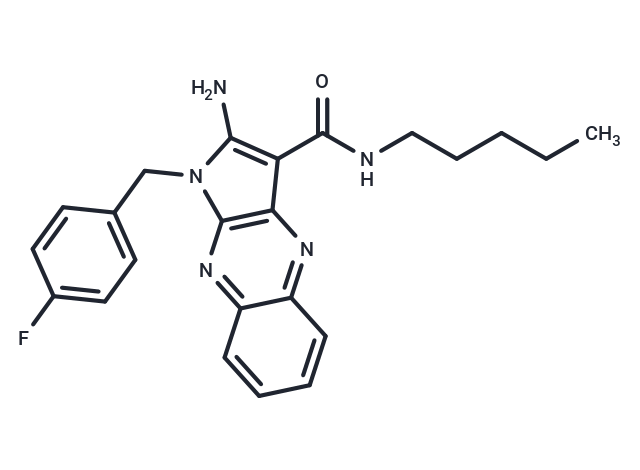Shopping Cart
Remove All Your shopping cart is currently empty
Your shopping cart is currently empty
2-APQC is a selective, orally active Sirtuin-3 (SIRT3) agonist (Kd=2.756 μM) that modulates mitochondrial homeostasis. It attenuates ISO-induced myocardial hypertrophy and fibrosis in vivo and in vitro, making it suitable for heart failure research. 2-APQC inhibits mTOR-p70S6K, JNK, TGF-β/Smad3, and ROS-p38MAPK pathways while activating PYCR1 and AMPK-Parkin, thereby suppressing necrosis and mitigating mitochondrial oxidative damage.

| Pack Size | Price | USA Warehouse | Global Warehouse | Quantity |
|---|---|---|---|---|
| 1 mg | $64 | - | In Stock | |
| 5 mg | $155 | - | In Stock | |
| 10 mg | $246 | - | In Stock | |
| 25 mg | $519 | - | In Stock | |
| 50 mg | $839 | - | In Stock | |
| 100 mg | $1,330 | - | In Stock | |
| 200 mg | $1,790 | - | In Stock | |
| 1 mL x 10 mM (in DMSO) | $169 | - | In Stock |
| Description | 2-APQC is a selective, orally active Sirtuin-3 (SIRT3) agonist (Kd=2.756 μM) that modulates mitochondrial homeostasis. It attenuates ISO-induced myocardial hypertrophy and fibrosis in vivo and in vitro, making it suitable for heart failure research. 2-APQC inhibits mTOR-p70S6K, JNK, TGF-β/Smad3, and ROS-p38MAPK pathways while activating PYCR1 and AMPK-Parkin, thereby suppressing necrosis and mitigating mitochondrial oxidative damage. |
| Targets&IC50 | SIRT3:2.756 (Kd) |
| In vitro | In H9c2 cells, 2-APQC (1, 10, and 100 μM, 24 hours) concentration-dependently activated SIRT3 deacetylation activity [1]. In H9c2 cells, 2-APQC (10 μM, 24 hours) reduced AcK68-MnSOD2, AcK122-MnSOD2, and acetylated lysine levels without significantly affecting SIRT3 protein expression [1]. In H9c2 cells, pretreatment with 2-APQC (1-100 μM) for 24 hours followed by Isoproterenol treatment for 48 hours ameliorated Isoproterenol-induced decline in cell viability. At 10 μM, it alleviated cardiomyocyte hypertrophy and reduced the expression of α-SMA and collagen I [1]. |
| In vivo | In the isoproterenol-induced rat heart failure model of Parazacco spilurus subsp. spilurus, 2-APQC (10-30 mg/kg, intragastric administration, once daily for 4 weeks) improved cardiac ejection fraction (EF) and fractional shortening (FS), reduced left ventricular end-systolic diameter (LVESD) and brain natriuretic peptide (BNP) levels, while alleviating myocardial hypertrophy and fibrosis, and downregulating the expression of myocardial injury markers such as serum lactic acid dehydrogenase (LDH) and aspartate aminotransferase (AST) [1]. In the ISO-induced heart failure model of wild-type male mice, 2-APQC (42 mg/kg, intraperitoneal injection, once daily for 4 weeks) improved cardiac function and alleviated myocardial injury, but this protective effect was completely abolished in SIRT3 knockout mice [1]. |
| Molecular Weight | 405.47 |
| Formula | C23H24FN5O |
| Cas No. | 500271-63-6 |
| Smiles | O=C(NCCCCC)C=1C=2N=C3C=CC=CC3=NC2N(C1N)CC4=CC=C(F)C=C4 |
| Color | White |
| Appearance | Solid |
| Storage | store at low temperature | Powder: -20°C for 3 years | In solvent: -80°C for 1 year | Shipping with blue ice/Shipping at ambient temperature. | ||||||||||||||||||||||||||||||
| Solubility Information | DMSO: 40 mg/mL (98.65 mM), Sonication is recommended. | ||||||||||||||||||||||||||||||
| In Vivo Formulation | 10% DMSO+40% PEG300+5% Tween-80+45% Saline: 2 mg/mL (4.93 mM), Sonication is recommeded. Please add the solvents sequentially, clarifying the solution as much as possible before adding the next one. Dissolve by heating and/or sonication if necessary. Working solution is recommended to be prepared and used immediately. The formulation provided above is for reference purposes only. In vivo formulations may vary and should be modified based on specific experimental conditions. | ||||||||||||||||||||||||||||||
Solution Preparation Table | |||||||||||||||||||||||||||||||
DMSO
| |||||||||||||||||||||||||||||||
| Size | Quantity | Unit Price | Amount | Operation |
|---|

Copyright © 2015-2025 TargetMol Chemicals Inc. All Rights Reserved.